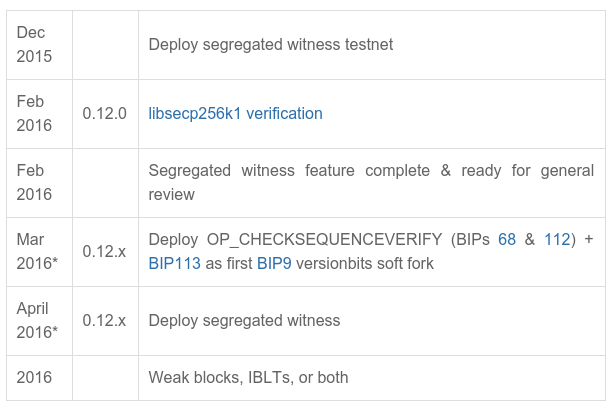
Ανακοινώθηκε το χρονοδιάγραμμα αναβαθμίσεων του Bitcoin core για το 2016
Ανακοινώθηκε από τους developer του Bitcoin το χρονοδιάγραμμα των αναβαθμίσεων για το 2016 στο πυρήνα του Bitcoin. Οι συμαντικότερες αναβαθμίσεις είναι η libsecp256k1 verification που αυξάνει την ταχύτητα συγχρονισμού των νέων node με το Blockchain κατά 500% καθώς και η δοκιμή και εφαρμογή τον Απρίλιο του 2016 του αναμενόμενου soft fork Segregated witness που θα φέρει την αποσυμφόρηση της χωρητικότητας των Bitcoin Block.
Περισσότερες λεπτομέρειες μπορείτε να διαβάσετε στο Bitcoin.org

* Dates with an asterisk are when we expect to release soft fork-ready code. The code will not be released until it has been well reviewed, and the actual fork will take time to activate (BIP66 activated in July 2015 after a few months; BIP65 activated in Dec 2015 after only 5 weeks).
- Segregated witness testnet: a separate testnet (not part of the regular testnet) that provides an opportunity for Bitcoin Core contributors to test segregated witness and for wallet authors to begin working with it.
- Libsecp256k1 verification: 500% to 700% speed boost on x86_64 hardware during verification to help new full nodes join the network and to lighten the burden on existing nodes.
- OP_CHECKSEQUENCEVERIFY: 25,000% improvement in bi-directionalpayment channel efficiency by allowing users to keep channels open as long as they want.
- VersionBits: increase the maximum number of soft forks able to be deployed simultaneously from 1 to 29, allowing for faster and more decentralized future upgrades of the network.
- Segregated witness: 175% to 400% direct capacity upgrade, 66% additional improvement in bi-directional channel efficiency by consolidating channel open and close operations, an end to third-party malleability that hurts smart contract deployment, fraud proofs to allow lightweight clients to better participate in economic enforcement, and ability to more easily upgrade Bitcoin’s Script language so that new and more powerful trustless contracts may be devised.
- IBLTs and weak blocks: 90% or more reduction in critical bandwidth to relay blocks created by miners who want their blocks to propagate quickly with a modest increase in total bandwidth, bringing many of the benefits of the Bitcoin Relay Network to all full nodes. This improvement is accomplished by spreading bandwidth usage out over time for full nodes, which means IBLT and weak blocks may allow for safer future increases to the max block size.
